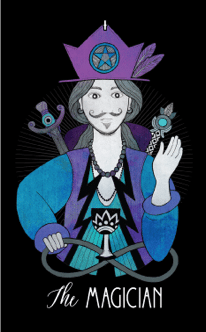
If you ask ten different people how to lay out tarot cards, you’ll get at least ten different answers. Tarot is a very intuitive craft and, though there are some basic things to keep in mind, the truth is that there is no one “right” or “wrong” way to lay out the cards. How you proceed depends more on what you want to achieve and what feels right to you than on any hard and fast rule.
So how does a newcomer know where to begin?
While there isn’t any “right” way to lay out your tarot cards, these guidelines that may make it easier:
- Choose your tarot deck – this should be a deck you feel connected to
- Know what you’re looking for in this reading and select the tarot spread that aligns with your aim
- Focus on your question as you shuffle the tarot cards – choose the shuffling method that works best for you
- Place the cards on the table and be open to the unexpected
Use a tarot deck of your choice
Everyone is different and there is no wrong tarot deck to use. Choose a tarot deck that works well for you – one that has a style that resonates with you. It’s most important that you feel a connection to the deck you use.
Choose a spread before you start
There are dozens, perhaps even hundreds, of existing patterns for laying out your cards (known as “spreads”) in use. Some of them are traditional, such as the 11-card Celtic Cross tarot spread or the 3-card Past, Present, and Future (Three Fates tarot) spread. Some have been created for a specific purpose or with a particular tarot deck in mind. More experienced readers often create their own spreads, but a traditional spread gives the newcomer a more solid framework and can act as a guide.
Which spread you choose will depend on what you want to achieve. Some spreads are meant for general, non-specific readings, while others are intended to focus on narrow issues (such as romance or career) or to answer specific questions. Choose the spread that feels right for your particular situation. Need help deciding? Chat with a gifted tarot reader on Keen to help you uncover which may be best for you.
Focus on your question
Since tarot is a means of gaining insight into a question or situation, one of the most important aspects of laying out the cards is infusing them with the energy of that question or situation. So while you’re preparing to lay them out, while you’re shuffling them, and while you’re physically laying out your spread, focus on the issue at hand. Think of it as a sort of meditation, and don’t let your mind wander to what you’re going to make for dinner or if you let the dog out.
Handle the cards
Again, the object is to translate your question to the cards so that they can provide the answer, so the more physical contact you have with them the better. You may want to simply hold the deck in your hands for a few moments before you shuffle them, focusing on the issue at hand. (If you’re reading for someone else, they should hold the cards and focus.) Once you feel the moment is right, shuffle the tarot cards thoroughly. Many people then cut the cards. Others feel that cutting them disturbs the flow. Use your intuition—if you feel they need cut, do so, and if not, don’t.
Put your cards on the table
Once you’ve focused on your question, shuffled the cards, and cut them if you’re going to do so, it’s time to actually lay them out. Typically, the cards are taken one at a time from the top of the deck and laid face-down on the table or other flat surface. This is certainly the easiest method and the best option if you’re reading for someone else. However, once again, there’s no “right” or “wrong” way to do things, and if you feel compelled to do something different, by all means do so. Some people, especially when reading for themselves, prefer to fan the deck out face down and choose the cards they feel most drawn to. Others may take cards at random from the deck. But, whichever method you choose, lay them face-down according to the pattern of the spread you’ve chosen, one card after another, till you’ve completed the spread. Then set the remainder of the deck to the side, face-down, and prepare to turn them over one at a time as you begin your reading.
Be open to the unexpected
The cards sometimes seem to have a mind of their own. A card may fall, or even fly, out of the deck as you shuffle. One or more cards may mysteriously fall out of the deck as you begin to lay out your spread. This doesn’t happen often, but when it does, pay attention. These maverick cards often have a message.
If an “escapee” card like this lands face-up, examine it carefully. What is it saying to you? If you haven’t begun laying out your spread yet, place it in the first position. If you have, look at it as a modifier to all the cards you’ve already laid out. If it’s face up, it wants to be seen and wants you to give it some serious attention. If it lands face-down, place it alongside the last card you laid out and read them both together when you get to that part of your reading.
As you practice and gain experience, and become familiar with your own personal tarot deck, you’ll discover that some things work for you while others don’t. You’ll develop your own rituals and routines. At some point, you may even find that modifying a particular spread gives you better results, or that a certain layout works best for you. You can also talk to a psychic on Keen to hone your intuitive tarot reading skills and personal tarot style. In the meantime, these basic guidelines are a good place to start and give you a general framework to work within.












